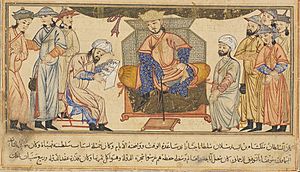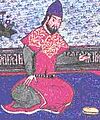Malik-Shah I facts for kids
Quick facts for kids Malik-Shah I |
|
|---|---|

Investiture scene of Malik-Shah I, from the 14th-century book Jami' al-tawarikh
|
|
| Sultan of the Great Seljuk Empire | |
| Reign | 15 December 1072 – 19 November 1092 |
| Predecessor | Alp Arslan |
| Successor | Mahmud I |
| Born | 16 August 1055 Isfahan, Seljuk Empire |
| Died | 19 November 1092 (aged 37) Baghdad, Seljuk Empire |
| Burial | Isfahan |
| Spouse |
|
| Issue |
|
| House | Seljuk |
| Father | Alp Arslan |
| Religion | Sunni Islam |
Malik-Shah I was a powerful ruler, the third Sultan of the Seljuk Empire. He ruled from 1072 to 1092. During his time, the Seljuk Empire became very strong and important.
When he was young, Malik-Shah joined his father, Alp Arslan, on military trips. He also learned from his father's main advisor, Nizam al-Mulk. In 1072, his father was badly hurt during a battle and died a few days later. After this, Malik-Shah became the new Sultan. However, his uncle, Qavurt, also wanted to be ruler. Even though Malik-Shah was the Sultan, Nizam al-Mulk had a lot of power in the empire. Malik-Shah spent his rule fighting enemies to the east and bringing order to the Caucasus region.
The reason for Malik-Shah's death is still debated today. Some historians believe he was poisoned by the caliph, al-Muqtadi. Others think he was poisoned by people who supported Nizam al-Mulk.
Contents
What's in a Name?
Malik-Shah was known by several names. His most common name, "Malik-Shah," combines two words for "king." "Malik" is an Arabic word, and "Shah" is a Persian word. Both mean "king."
Early Life and Rise to Power
Malik-Shah was born on August 16, 1055, in Isfahan. A historian from the 12th century described him as having fair skin, being tall, and a bit bulky.
In 1064, when Malik-Shah was only nine years old, he joined his father and Nizam al-Mulk on a military trip to the Caucasus. In the same year, he married Terken Khatun. She was the daughter of the Karakhanid ruler, Ibrahim Tamghach-Khan.
In 1066, his father, Alp Arslan, held a special ceremony. He named Malik-Shah as his heir, meaning Malik-Shah would rule after him. Alp Arslan also gave him the city of Isfahan as his own territory.
In 1071, Malik-Shah was part of his father's military trip to Syria. He stayed in Aleppo while his father fought the Byzantine emperor at the Battle of Manzikert. In 1072, Malik-Shah and Nizam al-Mulk went with Alp Arslan on a trip against the Karakhanids. During this trip, Alp Arslan was seriously injured. Malik-Shah quickly took charge of the army. Alp Arslan died a few days later, and Malik-Shah was declared the new Sultan.
Malik-Shah's Reign

Fighting for the Throne
Right after Malik-Shah became Sultan, his uncle, Qavurt, also wanted to be ruler. Qavurt sent a message to Malik-Shah, saying he was older and had a better right to his brother's empire. Malik-Shah replied that a brother does not inherit when there is a son.
This made Qavurt angry, and he took over Isfahan. In 1073, a battle happened near Hamadan. It lasted for three days. Qavurt fought with his seven sons and an army of Turkmens. Malik-Shah's army included loyal soldiers and troops from Kurdish and Arab groups.
During the battle, some of Malik-Shah's Turkish soldiers turned against him. But he still managed to win and capture Qavurt. Qavurt asked for mercy and promised to leave for Oman. However, Nizam al-Mulk said that sparing him would show weakness. After some time, Qavurt was killed, and two of his sons were blinded. After dealing with this challenge, Malik-Shah appointed new governors for different regions.
Wars with the Karakhanids
Malik-Shah then focused on the Karakhanids. After Alp Arslan's death, they had attacked Tukharistan. This area was ruled by Malik-Shah's brother, Ayaz, who was killed by the Karakhanids. Malik-Shah pushed back the Karakhanids and captured Tirmidh. He then made his other brother, Shihab al-Din Tekish, the ruler of Tukharistan and Balkh.
Around the same time, the Ghaznavid ruler, Ibrahim, was taking Seljuk land in northern Khorasan. Malik-Shah defeated him and then made peace. He even gave his daughter, Gawhar Khatun, in marriage to Ibrahim's son, Mas'ud III.
Other Military Actions
In 1074, Malik-Shah ordered a Turkic warlord to fix the damage he had caused in the land of Shirvanshah Fariburz I. The next year, Malik-Shah sent an army to Arran. This region was ruled by Shaddadid ruler Fadlun III. Malik-Shah's army easily conquered the region, ending Shaddadid rule. Malik-Shah then gave Gorgan to Fadlun III.
During Malik-Shah's rule, new schools were built. The Jalali calendar was also improved at the Isfahan Observatory. In 1086–87, he led a military trip to capture several cities like Edessa, Manbij, Aleppo, Antioch, and Latakia. He appointed Aq Sunqur as the governor of Aleppo. In 1089, Malik-Shah captured Samarkand with the help of local religious leaders. He imprisoned its Karakhanid ruler, Ahmad Khan. He then marched further east and made another Karakhanid ruler accept him as his superior.
Internal Affairs and Challenges
In 1092, Nizam al-Mulk was killed near Sihna. The killer was disguised as a Sufi and was immediately killed by Nizam's guards. So, it's not clear who sent him. Some believe it was an Assassin, as they often attacked Seljuk officials. Others think Malik-Shah might have ordered it because he was tired of his powerful advisor.
After Nizam al-Mulk's death, Malik-Shah appointed a new advisor, Taj al-Mulk Abu'l Ghana'im. Malik-Shah then went to Baghdad and wanted to remove the caliph, al-Muqtadi. He sent a message saying, "You must leave Baghdad to me, and go to any land you choose." Malik-Shah wanted to make his grandson the new caliph.
The Sultan generally got along with most Shia Muslims, except for the Ismailis led by Hassan ibn Sabbah. Sabbah's followers took over the Alamut fortress. An army sent by Malik-Shah could not recapture it. Another siege was stopped when Malik-Shah died.
Death and What Happened Next
Malik-Shah died on November 19, 1092, while he was hunting. He was most likely poisoned, either by the caliph or by those who supported Nizam al-Mulk. His body was taken back to Isfahan and buried in a madrasa (a type of school).
After his death, the Seljuk Empire fell into disorder. Different leaders and governors fought each other for control. This made things even more complicated when the First Crusade began. The Crusaders took over large parts of Syria and Palestine in 1098 and 1099. The success of the First Crusade was partly due to the political confusion after Malik-Shah's death.
Personality and Achievements
Malik-Shah was very interested in science, art, and literature. The Isfahan Observatory was built during his rule. The Jalali calendar was developed based on the work done at this observatory. He also loved architecture and built many beautiful mosques in his capital, Isfahan.
He was tolerant of different religions. During his reign, people in the Seljuk Empire enjoyed peace and religious freedom. Malik-Shah also appreciated poetry, and the famous poet Omar Khayyam lived during his time.
Even though he was one of the most powerful rulers of his era, Malik-Shah was believed to be humble. A story says that during the Seljuks' most successful years, Malik-Shah would climb a hill and say, "Oh Almighty God, I will somehow handle hunger, please save me from too much abundance."
Malik-Shah did not spend as much time on military trips as his father, Alp Arslan. Isfahan became his main home, though he preferred to spend winters in Baghdad later in his rule. He lived in Isfahan for more than half of his reign. Isfahan also became the burial place for Malik-Shah and his family.
Images for kids


